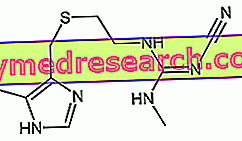
What is Cimetidine?
Cimetidine is the progenitor of the histamine H2 receptor antagonists and can undoubtedly be considered a milestone, not only in the development of this class of drugs, but also in the history of pharmaceutical chemistry.
Cimetidine was the first developed H2 antagonist, from which all other molecules belonging to this class of drugs were derived.
Cimetidine was the product obtained from the finalization of an important project of the then SmithKline & French in the 60s-70s.

Cimetidine was marketed for the first time in Great Britain in 1976 under the registered name Tagamet; today it can also be found as a generic drug under the name of the molecule itself, that is cimetidine. From the beginning of the project to the marketing of the same cimetidine it took about 12 years, and it was the first drug in the world that reached a billion dollars in earnings per year. It can be said that cimetidine changed the life of patients suffering from gastritis and that it is still a drug widely used all over the world.
Posology and method of use
Cimetidine can be administered either orally or parenterally (intravenously and intramuscularly) according to various therapeutic needs.
Duodenal ulcer treatment
In the treatment of duodenal ulcer, by the oral route, cimetidine is taken from 800 to 1600 mg / day in a single daily administration, before going to bed. Alternatively, 1200 mg / day can be taken divided into 4 daily doses of 300 mg each, three at main meals and one at bedtime. To avoid the onset of stomach irritation, it is recommended to take the medicine on a full stomach whenever possible. The duration of treatment depends on the therapeutic response, but normally varies from 4 to 8 weeks; if complete healing does not occur, the treatment can be extended even for longer periods. If, on the other hand, the duodenal ulcer is being treated parenterally, injections of 300 mg of cimetidine intravenously or intramuscularly are used every 6.8 hours. Or, alternatively, cimetidine can be administered in continuous infusion from 40-50 mg per hour up to a maximum of 100 mg / hour (2.4 g / day) depending on the need. In the case of prophylactic (preventive) therapy of the duodenal ulcer, 400 mg / day of cimetidine is used, administered in a single dose, orally, before bedtime, or 300 mg / day for intravenous or intramuscular injection, always in a single administration .
Treatment of gastric ulcer
In the treatment of gastric ulcer, orally, 800 mg / day of cimetidine is used in a single administration, in the evening, before going to bed. In cases where a higher dose is needed, 1200 mg / day can be used, divided into 4 daily administrations. It is recommended to administer the drug on a full stomach. in the case of parenteral gastric ulcer treatment, 300 mg of cimetidine is used for intravenous or intramuscular injection every 6 hours. Alternatively, a continuous intravenous cimetidine infusion can be used at a rate of 50 mg / hour.
Treatment of Zollinger-Ellison syndrome
Cimetidine is also quite used in the treatment of Zollinger-Ellison syndrome. Orally cimetidine uses 1200 mg / day divided into four daily administrations, one at each meal and one before going to bed; parenterally intravenous or intramuscular injections of 300 mg of cimetidine are used every 6 hours. Alternatively, they can be administered by continuous infusion - initially - 50mg of cimetidine per hour; later, based on the therapeutic response, cimetidine is used from 40 to 500 mg / hour; in any case, the daily dose should not exceed 2400 mg.
Treatment of gastroesophageal reflux disease
In the treatment of gastroesophageal reflux disease, orally, 1600 mg / day of cimetidine is used, divided into two administrations or into four daily administrations of 400 mg each. By injecting, on the other hand, the doses used are 300 mg of cimetidine administered by intravenous or intramuscular injections every 6 hours, or - alternatively - a continuous infusion of the drug can be administered at the rate of 50 mg / hour.
All the doses mentioned above refer to adult patients.
Contraindications and warnings
Before starting a treatment with cimetidine against stomach ulcers it is essential to ascertain that the symptoms of gastric suffering are not due to a malignant neoplasm, since stomach cancer is characterized by symptoms similar to those generated by gastric ulcer ; these symptoms are relieved by cimetidine. Thus, cimetidine can mask the symptoms of neoplasia formed in the stomach, thus delaying the correct diagnosis of the disease. This type of assessment is particularly important if the patient is of advanced age or if he has complained of new symptoms or a recent change of them.
Recent extensive studies have shown that in elderly patients with diabetes, chronic pneumonia or a compromised immune system (due for example to chemotherapy treatments or diseases such as AIDS) there is a higher risk of developing pneumonia if they are being treated with cimetidine or other H2 antagonists. Therefore, you should tell your doctor if a cough or other symptoms of a chest infection develops during treatment. Simultaneous use of cimetidine and alcohol can lead to an increase in the concentration of circulating alcohol. The biological explanation seems to be related to the inhibition of gastric alcohol dehydrogenase by cimetidine, which leads to an increase in the bioavailability of alcohol and an inhibition of the hepatic metabolism of the alcohol itself.
From other studies it has been confirmed that cimetidine inhibits the oxidative metabolism of drugs. For example cimetidine increases the anticoagulant effect of Warfarin, therefore it is advisable to keep under control (prothrombin time) the patients taking Warfarin and cimetidine at the same time. Cimetidine can prolong the effect of other important drugs such as beta-blockers and diazepam.
Pregnancy and breastfeeding
Animal studies have shown no risk to the fetus regarding the use of cimetidine in pregnancy. Unfortunately there are no complete studies in human pregnancies. It has been confirmed that cimetidine crosses the placenta, albeit slowly, by passive diffusion in both directions.
Although in several cases cimetidine has been used without any risk during pregnancy in the treatment of gastric ulcer, it is strongly recommended to use it only if really necessary. Data from other studies suggest that - obviously - fetal exposure is greater if chronic doses of a total of cimetidine X mg are used rather than a single administration of the same X dose, so cimetidine can be used during childbirth to prevent Mendelson's syndrome. The use of cimetidine during childbirth does not interfere with the duration of the birth or with the contractions during the same.
Cimetidine has been proven to be secreted into human milk. During the administration of 400 mg of cimetidine in a patient, the peak concentration of the drug in milk reached 5 mcg / ml. These concentrations do not vary when chronic cimetidine is continued. Although manufacturers recommend not using cimetidine during breastfeeding, according to the American Academy of Pedriatics, cimetidine intake is considered compatible with breastfeeding.
Side and unwanted effects
In most patients treated with cimetidine, no side effects occurred. However, like all drugs, cimetidine can also cause unwanted side effects. The most common are gastrointestinal ones, such as diarrhea, which affects one percent of cimetidine-treated patients. Other side effects that can occur when taking cimetidine are those affecting the central nervous system (especially in elderly patients), such as headaches, reversible confusional state and extrapyramidal disorders; the clinical picture becomes worse in patients with severe renal failure. In other, much rarer cases, side effects related to the cardiovascular system, such as bradycardia, atrial and ventricular extrasystoles, and ventricular tachycardia have been reported. Other cases reported are those related to hepatic metabolism, with an increase in serum transaminases, which however tend to normalize during the course of cimetidine treatment.



